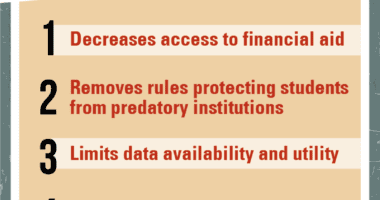The Education Trust’s Letter to U.S. Senators on Advancing Equity for Students of Color
The Honorable Doug Jones
United States Senator
Washington, DC 20510
The Honorable Elizabeth Warren
United States Senator
Washington, DC 20510
The Honorable Kamala D. Harris
United States Senator
Washington, DC 20510
The Honorable Catherine Cortez Masto
United States Senator
Washington, DC 20510
Dear Senators,
On behalf of The Education Trust, an organization dedicated to closing long-standing gaps in opportunity and achievement that separate low-income students and students of color from their peers, thank you for the opportunity to share ideas and proposals for advancing educational equity, addressing racial disparities in student debt, and improving outcomes for student borrowers of color.
We are grateful for your attention to this important matter and your willingness to engage with experts in the field to explore a range of potential policy approaches. As the data summarized in your letter clearly show, our current system of higher education leaves an unconscionable share of students of color with limited economic opportunities, struggling with debt they can’t afford and forcing them to put their American dreams on hold.
This is particularly true for Black borrowers, who have a 50-50 chance of defaulting on a federal loan within 12 years of entering college.1 Even controlling for parental education, income, dependency status, gender, age, and first institution attended, Black borrowers are over 150 percent more likely to default on a federal loan than their White counterparts.2 Equally distressingly, Black bachelor’s degree completers are more likely to default on federal loans (21 percent) than White college dropouts (18 percent).3
Racial gaps in degree attainment and loan repayment are the result of factors including, by no means limited to, pervasive and persistent disparities in postsecondary access and success, rising tuition, insufficient and underfunded grant programs (including Pell Grants and state need-based aid), state disinvestment in public higher education, underfunding of the schools and colleges students of color attend, predatory practices within the for-profit sector of higher education, discrimination in the workforce, and massive racial wealth gaps that represent the continued legacy of slavery. These factors are often created and reinforced through policies enacted by federal, state, and local governments.
Centuries of discriminatory policymaking have effectively excluded Black Americans and other people of color from wealth-generating opportunities. It is unreasonable, unjust, and utterly impractical to ask them to attempt to make up the difference by taking on debt to pursue the postsecondary degrees that have become a prerequisite for the vast majority of living-wage jobs. The debt-reliant financing of public
higher education expands the chasm between White and Black wealth and leaves many Black families with negative net wealth.
However, the current moment presents a tremendous opportunity to use policy to change course and make significant strides in closing gaps in educational opportunity. Your willingness to directly address the plight of borrowers of color is an encouraging first step, and we hope the suggestions we offer here will help you begin to formulate a path forward for truly reckoning with the deep disparities that
hamper the postsecondary and workforce success of students of color.
When it comes to addressing a problem as large as this, you can either cure the disease or treat the symptoms.
Ed Trust Recommendation: Curing the Disease
Your letter posed a question of how to address racial disparities in student debt and the challenges faced by students of color. The shortest and truest answer is this: Fund higher education so that people who have not historically had wealth can earn a quality degree without incurring debt, and provide retroactive relief to those who have already left college with debt.
We urge you to think first about ways to fundamentally restructure the funding of postsecondary education so that students of color whose families have not had the opportunity to accumulate wealth are not required to rely on debt in order to earn a quality postsecondary degree. For such students, this would mean eliminating the cost of tuition and providing access to the resources that would enable them to enroll in college and complete a degree in a timely manner, including financial support for nontuition expenses like books, housing, food, and transportation. These non-tuition expenses account for a significant portion of the total cost of college — for example, they constitute 80 percent of college costs for the average community college student4 — and a growing body of evidence shows that a substantial portion of college students struggle to pay for necessities such as food and housing.5 In order to truly make progress on addressing racial disparities, Black Americans and those belonging to other marginalized racial groups must have access to high-quality debt-free college opportunities.
In addition to resolving affordability issues for new students, a comprehensive approach to addressing racial disparities in student debt will require providing substantial debt relief for the borrowers of color who, due to their family’s inability to accumulate wealth, had no choice but to take out loans to finance their postsecondary education. Such substantial relief would need to be, at a minimum, available to struggling borrowers, including those who left college without a degree, and particularly those who attended institutions that overcharge and under-deliver.
Ed Trust Recommendation: Treating the Symptoms
In the absence of immediate, expansive, and foundational policy changes, there are a number of options for lawmakers to alleviate burdens for students of color in the near-term. These include reforms aimed at addressing front-end affordability, student success, institutional accountability, and back-end debt relief. These suggestions are by no means comprehensive, nor are they exhaustive, but we would be happy to provide more details on how to operationalize the broad proposals listed below and discuss how their adoption would improve outcomes for students of color.
Improve Front-End Affordability
- Improve the Pell Grant program
- Increase the maximum Pell Grant and put it on a path to covering half the cost of attendance at a public four-year institution
- Shift to 100 percent mandatory funding for Pell
- Expand eligibility to undocumented students and incarcerated students
- Establish a state-federal partnership to guarantee debt-free education to low-income and low-wealth students. See Ed Trust’s report, A Promise Fulfilled, for a framework for designing equity-driven free college programs
- In general, base eligibility for means tested federal benefits (e.g. SNAP, TANF, and childcare, healthcare, and housing supports) on the full picture of family resources, including wealth in addition to income
- Work with campuses to improve the racial diversity and cultural competency of financial aid administrators, counselors, and advisors
- Improve the federal financial aid application process and needs analysis formula
- Simplify the application process for students and families
- Improve the federal needs analysis for financial aid to better account for wealth, including negative wealth and existing family debt burdens
- Remove barriers for justice-impacted students (Remove Question 23 on the FAFSA)
- Ensure that low-income students and students of color are eligible for the support they need to complete a degree in a timely manner
- Bundle and streamline federal aid and other benefits (e.g., SNAP, housing vouchers)
- Provide support for students who are juggling work and family obligations (including access to affordable childcare)
- Provide emergency grant aid to students facing sudden financial shortfalls
Invest in Student Success
- Hold states accountable for adequately and equitably funding their public colleges
- Work with states, institutions, and K-12 schools to address enrollment stratification (i.e., students of color being disproportionately enrolled at community colleges, for-profit institutions, and less selective institutions)
- Provide additional resources to campuses that serve as “engines of mobility” for low-income students and students of color to scale up practices with strong evidence of effectiveness
- Provide additional resources to campuses that enroll large shares of students of color but do not produce desired results to improve outcomes by implementing evidence-based practices
- Make significant new investments in Title III and Title V capacity building programs for minority-serving institutions
Enhance Institutional Accountability
- Create pressure (via incentives and/or penalties) and provide support to improve equitable access and completion
- Improve accreditation by increasing the focus on access, equity, and student success
- Enhance consumer protections and improve oversight of the for-profit sector
- Maintain and strengthen current accountability provisions, including the 90/10 rule and gainful employment regulation
- Overturn the ban on creating a student unit record system and create a student level data network that disaggregated data by race and income
- Enhance data collection and transparency, including by improving the IPEDS and NSLDS data systems so that critical measures of student success can be disaggregated by race.
- Provide incentives to states to establish and or strengthen seamless transfer processes between two-year and four-year institutions Provide Back-End Debt Relief
- Provide substantial debt relief for borrowers whose families have not had the opportunity to accumulate wealth
- Provide more generous debt relief for distressed borrowers
- Address issues of intergenerational debt, including by providing targeted relief for Parent PLUS loan borrowers and student parents
- In general, base eligibility for reductions in monthly payments and debt relief on the full picture of family resources, including wealth in addition to income
- Eliminate the taxation of forgiven debt
- Strengthen the borrower defense to repayment process
- Make income-based repayment (IBR) easier to access and maintain
- Automatically enroll distressed borrowers in IBR
- Require less frequent income certification or provide for automatic certification using IRS records
- Improve loan servicing and the oversight of servicers to ensure borrowers’ best interests are prioritized
Thank you again for inviting The Education Trust to comment on this important topic, and for seeking input on policies to support students of color. As you move forward in this work, we urge you to prioritize proposals that reflect the magnitude of racial inequities in this country and address the full spectrum of contributing factors. We look forward continuing to contribute to your efforts to advance racial justice and equity through higher education.
Sincerely,

Wil Del Pilar
Vice President of Higher Education Policy and Practice
The Education Trust
1 Ben Miller, “New Federal Data Show a Student Loan Crisis for African American Borrowers,” Center for American Progress, October 16, 2017, https://www.americanprogress.org/issues/education-postsecondary/news/2017/10/16/440711/new-federal-data-show-student-loan-crisis-african-american-borrowers/
2 Robert Kelchen, “Examining Long-Term Student Loan Default Rates by Race and Ethnicity,” February 13, 2018, https://robertkelchen.com/2018/02/13/examining-long-term-student-loan-default-rates-by-race-and-ethnicity/
3 Judith Scott-Clayton, “The Looming Student Loan Default
Crisis Is Worse Than We Thought,” Brookings, January 11, 2018, https://www.brookings.edu/research/thelooming-student-loan-default-crisis-is-worse-than-wethought
4 “Average Estimated Undergraduate Budgets, 2018-18,” The College Board,
https://trends.collegeboard.org/college-pricing/figures-tables/average-estimated-undergraduate-budgets-2018-19
5 Larin, Kathryn, “Food Insecurity: Better Information Could Help Eligible College Students Access Federal Food
Assistance Benefits,” United States Government Accountability Office, December 2018,
https://www.gao.gov/assets/700/696254.pdf

